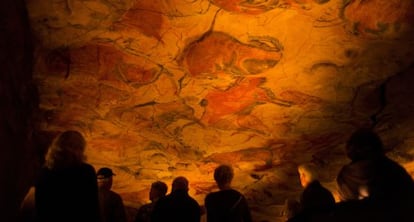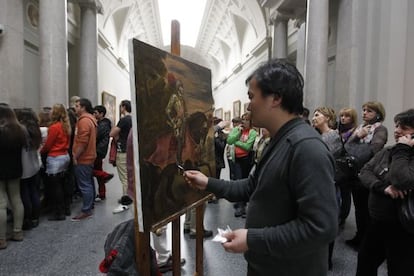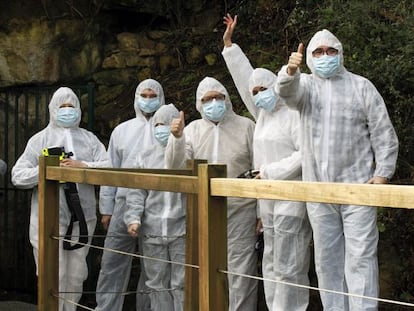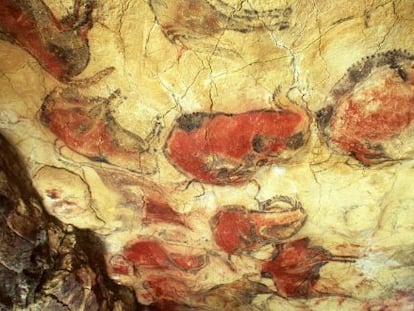With a copy this good, who would miss the original?
Last month, five members of the public were allowed to see Altamira's prehistoric cave paintings But some said the experience was not that different to seeing the replica in the nearby museum


Since it was opened 12 years ago, some 250,000 people have visited the replica of the Altamira cave in northern Spain, giving them a pretty good idea of what is to be found in the original: one of the few surviving examples of prehistoric paintings left on the planet. The copy, known as the neocueva (neo-cave), has proved such a success that two visitors to it, who won a lottery to visit the original, said they really couldn’t see much difference between the replica produced in 2001 in the museum close to the Altamira cave complex in Santander, and those painted some 18,500 years ago by a few anonymous hunter-gatherers. “It’s not nice to say it, but they both look the same to me; in the original you look at the painting with torches, while the replica is conveniently lit,” said one of the five lucky visitors to the original cave, who freely admitted his own lack of “awareness” of the finer points of cave art.
Discovered in 1879, amid a complex of subterranean caverns near the upmarket seaside resort of Santillana del Mar, the caves have been opened and closed to the public several times. The need for a replica of the cave paintings became clear when the originals began to show signs of damage as a result of exposure to thousands of visitors over the decades.
By the early 1970s, up to 170,000 people a year were trooping through the caves. They were closed in 1977, when scientists discovered that the paintings in red, ochre and black were being damaged by carbon dioxide exhaled by visitors.
The site was reopened in 1982, this time with strict visitor limits. This led to waiting times of up to three years. In 1985, the caves were declared a World Heritage Site. But the decision was made to close them again in 2002, when green mold was discovered on some of the images. Experts blame the deterioration on a change in the fragile atmosphere of the cave caused by a combination of light, visitors’ body heat, and moisture from their breath.
Polls show that 80 percent of visitors to the Altamira replica say they are happy with the copy
Gaël de Guinche, Altamira’s head of conservation, says he and his team faced a simple question: either allow people to see the original, which would eventually result in its destruction, or seal the cave off to protect it, meaning that nobody would ever see the paintings. That said, he is clear which he prefers: “Nothing compares to the original: it’s not just about the paintings, but the location, the humidity, the darkness, the cold, the whole experience,” he says.
Polls show that 80 percent of visitors to the Altamira replica say they are happy with the copy, and 90 percent recommend others take a trip there. The replica, built by Empty, a company specializing in museum exhibits, was a pioneering experiment. The man in charge of the project, Sven Nebel, is based in Alcalá de Henares, 35 kilometers east of Madrid.
“Reproduction techniques were still relatively unsophisticated 15 years ago, but the team, which included archeologists, historians, geologists and the hyperrealist painter Manuel Franquelo, produced something very exact,” says Nebel. Using a three-dimensional scanner and a laser, a copy was made of the original cave. Two Spanish artists, the husband-and-wife team Pedro Saura and Matilde Muzquiz, used the same pigments as the original to recreate the paintings of Altamira’s famous bison: ochre, charcoal and water.
The Altamira debate extends into the realm of more recent art. Two years ago, Madrid’s Prado art museum announced that it was in possession of a perfect copy of the Mona Lisa, which had been painted simultaneously alongside the original by one of Leonardo’s disciples. Copy or not, the Prado’s Giaconda immediately became one of the museum’s star attractions, garnering more attention than the masterpieces it jostles for space with – which are, after all, originals.
When they visit the replica, they’ll see that it is a much better experience"
Miguel Zugaza, the Prado’s director, says that producing copies of masterpieces is a practice that dates back to antiquity. “What we know about Greek art is largely due to Roman copies. In the 11th century there were museums filled with reproductions. The Casón del Buen Retiro [part of the Prado] specialized in castings of great works of sculpture. But gradually, we began to see value only in the original, and this continues today: but the truth is that the technical advances of recent times opens a whole new field for museums in terms of research, conservation, and rescuing things that have been lost or damaged,” he says.
The Casón del Buen Retiro closed to the public in 1961, and its collection of copies was put in storage. In 2012, it was re-housed in the Casa del Sol, in the northern city of Valladolid. One of its most important pieces is currently on display in the Prado: Laocoön and His Sons, perhaps the most famous group sculpture of all time, and which has inspired works by Rubens, Titian, and Michelangelo. The original is in The Vatican.

The Prado is also proud of its copy of Mateo de Bonarelli’s Golden Lion, which has been on display since 2005. “It’s not just about protecting the originals or recreating lost works,” says Zugaza. “It’s also interesting to use reproduction techniques to return works to their original location, such as church tableaux, or the magnificent copy of The Wedding at Cana.”
The original was plundered by Napoleon from the San Giorgio Maggiore monastery in Venice, and now hangs in the Louvre, in Paris, and is the museum’s largest work. A copy was commissioned in 2006, and carried out by Factum Arte, a company based in Madrid and London that is an expert in creating copies of great works.
Our work sees the original not in some fixed state, but as part of a process of change"
Adam Lowe leads a team of 40 artists, technicians and conservationists, which in recent years has worked with the Louvre, the British Museum, the Pergamon, the Prado and many other museums around the world. Its most ambitious project to date is the reproduction of the tomb of Tutankhamen, which is to open on a site close to that of the original. Factum Art is now working on replicas of the tombs of two other ancient Egyptian monarchs, Seti and Nefertitit. “In 2010, more than 1,000 people a day traipsed through the original tomb of Tutankhamen,” says Lowe. “It’s in a critical condition.”
After the original was scanned in high resolution, the data processing and production of the facsimile was done in Madrid. “We would like visitors to first pass through the original, and then, when they visit the replica, they’ll see that it is a much better experience. It is important to explain why the original is so deteriorated, along with the challenges of conserving a place that was not meant to be visited by thousands of people every week,” says Lowe.
“Egypt needs tourism, but the real question is whether we want to be part of a conservationist model or a selfish and destructive model that doesn’t think about the rights of future generations,” he says, adding: “Our work is the result of serious research that sees the original not in some fixed state, but as part of a process of change over time.”
The job of any museum is to protect and conserve its collection, but should that be done at the cost of detaching them from what some philosophers have called their “aura of humanity”?
Perhaps what we’re really looking for are simply unique experiences
German thinker Walter Benjamin warned almost a century ago of the dangers of losing what he called the authenticity of art works by exhibiting them. In his essay entitled “The Work of Art in the Age of Mechanical Reproduction,” he defined authenticity in the following terms: “Even in the most perfect of reproductions something is left out: the here and now of the work of art, its unique existence in the place where it finds itself. The history that a work of art has been subjected to over its lifetime is something that pertains exclusively to it, to its unique existence.”
José Antonio Lasheras, the director of the Altamira Museum, disagrees. He says that copies help us understand originals, allowing us to recapture the natural architecture of a place, its lost magic. “We reproduce the exact physics and chemistry of the material, the object, the place of its alchemy, the aura that Benjamin talks about, we provide scientific information in a kinder, sympathetic, synthesized way. But the Neocueva is not meant to be a substitute. In some ways it is more faithful to the original Paleolithic cave than the original that has come down to us through the centuries.”
In the final analysis, perhaps what we’re really looking for are simply unique experiences. In 2010, German filmmaker Werner Herzog made a documentary about the Chauvet cave, which was discovered in France in 1994, and then immediately closed. Its spectacular paintings date back 30,000 years, and the French government is so worried about protecting it that its whereabouts are known to only a few scientists. But Herzog was given permission to make a film that now provides a powerful experience of the caves – in its own way, it’s a replica that allows anybody to visit a place that only a privileged few will ever see firsthand.
Herzog shares Benjamin’s belief that our constantly changing world has lost one of its fundamental senses: that of reality. This is no longer simply about pillaging the world to feed the museums of the West, or follies such as the exact replica of the Parthenon built in 1897 to commemorate the centenary of Tennessee’s union with the United States. Instead, we have to understand the copy’s purpose, its role in conserving our heritage, and its important function as a way of increasing our knowledge – in short, a symbol of mankind’s infinite ability to create, destroy, and in the final analysis, to rise up against the suicide of our memory.
Tu suscripción se está usando en otro dispositivo
¿Quieres añadir otro usuario a tu suscripción?
Si continúas leyendo en este dispositivo, no se podrá leer en el otro.
FlechaTu suscripción se está usando en otro dispositivo y solo puedes acceder a EL PAÍS desde un dispositivo a la vez.
Si quieres compartir tu cuenta, cambia tu suscripción a la modalidad Premium, así podrás añadir otro usuario. Cada uno accederá con su propia cuenta de email, lo que os permitirá personalizar vuestra experiencia en EL PAÍS.
¿Tienes una suscripción de empresa? Accede aquí para contratar más cuentas.
En el caso de no saber quién está usando tu cuenta, te recomendamos cambiar tu contraseña aquí.
Si decides continuar compartiendo tu cuenta, este mensaje se mostrará en tu dispositivo y en el de la otra persona que está usando tu cuenta de forma indefinida, afectando a tu experiencia de lectura. Puedes consultar aquí los términos y condiciones de la suscripción digital.
More information

“You have to see this before you die”
Últimas noticias
How Japan is trying to avert ‘digital defeat’
From digital curfews to blocking apps: How technology experts protect their children online
Why the price of coffee has skyrocketed: from Brazilian plantations to specialty coffee houses
Confined to a Cuban hospital: When electricity is a matter of life or death
Most viewed
- Pablo Escobar’s hippos: A serious environmental problem, 40 years on
- Reinhard Genzel, Nobel laureate in physics: ‘One-minute videos will never give you the truth’
- Why we lost the habit of sleeping in two segments and how that changed our sense of time
- Charles Dubouloz, mountaineering star, retires at 36 with a farewell tour inspired by Walter Bonatti
- The Florida Keys tourist paradise is besieged by immigration agents: ‘We’ve never seen anything like this’









































